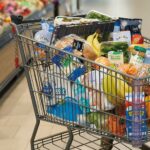
It may sound unfair and even vaguely socialistic to some. But when it comes to retail, it could be just plain common sense. A new retail report says now is the perfect time for stores to raise prices for those who can afford to pay – and lower prices for everyone else.
That’s one of the highlights from the research firm TABS Analytics’ newest annual Food and Beverage Consumables Study. Each year, the report examines our grocery shopping and saving habits. And this year, the eighth year of the survey, the coronavirus pandemic has changed everything. Supply chain problems and other challenges have prompted manufacturers and retailers to cut back on coupons and promotions – just when many cash-strapped shoppers need them the most.
But some shoppers are still gainfully employed, and don’t bat an eye at paying full price. So why not raise prices for them, so retailers and consumer packaged goods (CPG) companies can afford to offer more deals for those who need them?
“The environment for increasing prices in CPG has never been better, as demand is high and supplies are more limited than usual,” TABS says. And yet, “assuming no supply constraints, there is no reason to pull back on promotions.” How can both of these things be true? “That’s kind of the way you segment the market,” TABS Analytics executive chairman and founder Kurt Jetta explained. “Promotional pricing for people that are struggling or have more limited incomes, and increasing price on people that can afford it.”
The advice comes as manufacturers and retailers are facing increased costs of their own, as they’ve had to ramp up production of high-demand items, devote more resources to online order fulfillment, while trying to keep their own employees safe. Many have responded by offering fewer coupons and deals. But TABS says that’s the wrong approach.
“Retailers and manufacturers are cutting back sharply,” Jetta said, but “consumers, more than ever during COVID, want and need deals.”
Each year, TABS surveys shoppers to find out what and how many deal-seeking tactics they’re using. As compared to last year, roughly the same percentage of people this year are categorized as “heavy deal users,” taking advantage of at least seven different types of deals. But many more shoppers this year moved from “light deal users” to “medium” – increasing their deal usage from none or one, to up to six.
Of the ten deal categories that TABS tracks, all of them saw increases in the percentage of shoppers who seek them out. The most popular deal-seeking tactic each year is also the most passive – seeking out stores with everyday low prices. The percentage of shoppers who choose this tactic jumped from a low of 59% last year to a near record-high 67% this year. The biggest jump occurred in the category of bulk-sized purchases – while 34% chose to save money by stocking up last year, 43% did this year, representing an all-time high. It makes sense, as these “gains appear to align with higher needs to stock up to minimize store trips,” TABS explains.
As for those old standbys – printed circulars and paper coupons – both also saw gains. 43% consult their stores’ weekly ads, up from 36% last year. And 25% clip coupons from the Sunday newspaper inserts, up from last year’s low of just 21%. TABS says its findings show the continued importance of circulars – but when it comes to paper coupons, it’s not impressed. TABS dismissed the increase in paper coupon usage as “a ‘dead cat bounce,’ in which short-term gain is obscured by significant long-term decline.”
“As people are home more, it stands to reason that they may be more likely to use newspapers” and the coupon inserts they contain, Jetta said. But overall, paper coupon use has plummeted since 2013, the first year of TABS’ survey. Back then, 45% of shoppers reported using coupons from the Sunday newspaper inserts. But nearly every year since, that percentage has declined precipitously. “It’s questionable if that thing’s going to last,” Jetta said of the printed coupon insert.
But that doesn’t mean shoppers don’t want to save. It just means they want to save differently. Every year, TABS points out that the heaviest deal-seekers are also the heaviest buyers. “Consumers that use more deals buy more stuff. It’s an incentive to buy,” Jetta said. “It is absolutely irrefutable, the cause and effect that offering more deals drives more sales.”
So, especially at a time like this, cutting back on deals is counterproductive, TABS argues. “One of my life’s missions,” Jetta said, in comments directed at marketers, “is to disabuse people of the notion that deals are bad. They can and should be good. You can and should be making money at it. And just because you’re executing them poorly doesn’t mean that you should eliminate them or try to reduce them.”
If marketers are worried about their profits in this difficult time, TABS says they should raise their everyday prices, so less price-sensitive shoppers will pay more. And they should offer plenty of deals, so more price-sensitive shoppers can pay less – and reward retailers and brands with increased purchases and greater loyalty.
With few of us spending money on vacations or other big-ticket discretionary items these days, the grocery industry “is uncharacteristically strong,” TABS concludes. “While there is a rationale for deeper and more frequent promotional pricing, there is equally a strong rationale for increases in everyday price, given the growth in demand.” TABS thinks it’s better for everyone if the industry can do both – just as long as you find yourself on the right side of the equation.
Image source: Walmart










